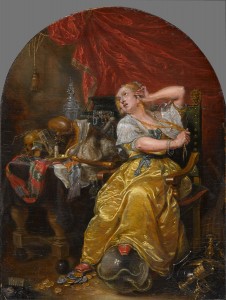By Caroline Pinney

Allegory of Vanity is a vanitas piece completed in 1651 by Matthijs van den Bergh.
This work, painted with oils on an oak panel, shows a woman adorned with jewelry and surrounded by various objects. A vanitas painting is a Dutch painting whose purpose is to show a theme of vanity. Several symbols portray that this is a vanitas painting, one of them being pearls. Here, the woman wears pearls in her ears. There are different interpretations of what the pearl can symbolize in paintings, and here the pearl symbolizes vanity based entirely off of the context of the painting as a whole. Other extravagant objects, such as gold chalices and coins, are meant to serve as objects of futility as well.
There are other elements within this painting, in addition to the costly commodities, that affect the entire context of this vanitas piece. Aspects such as a human skull, a subtle reflection within an object, and a candle are shown with particular reason. These dark objects give a bigger meaning to the work and serve as a lesson regarding vanity as well as a reminder of the brevity of life. These objects are placed strategically alongside the adorned objects to prompt the viewer of the transience of life, and moreover to demonstrate a lesson on vanity and virtue.